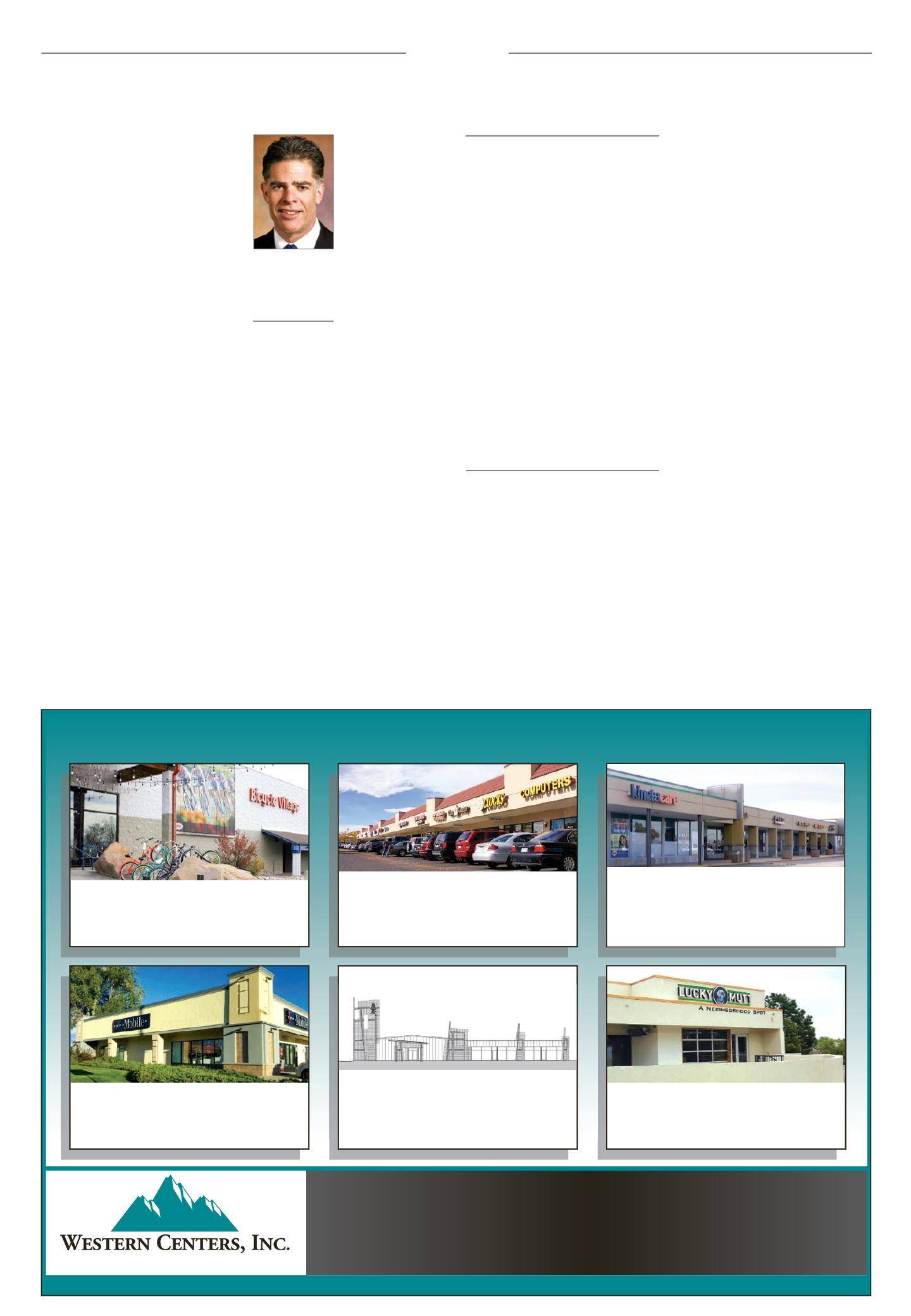

Page 8
— Retail Properties Quarterly — November 2017
www.crej.comLeasing
I
grew up with three brothers,
so the first question we asked
when we got home from
school was, “What’s for din-
ner?” Today, for many families,
it’s, “Where should we go for din-
ner?”
My parents took us out to dinner
about once a month and usually it
was to a local all-you-can-eat place
to top our tanks. Almost all of our
meals were prepared at home and
going out to eat was something spe-
cial.
Today, often “cooking” looks like
picking up a prepared meal from
Whole Foods or King Soopers, heat-
ing it up and maybe putting it in a
serving dish – or going out to eat at
a fast-casual restaurant. The aver-
age American now goes out to eat
over four times per week. “From
2015 to 2016, for the first time in
history, Americans spent more
money at bars and restaurants
($54.9 billion) than they did on gro-
ceries ($52.5 billion),” according to
Motley Fool.
This growth has been supported
by a juggernaut of new restaurant
concepts and related space in our
shopping centers, especially in the
fast-casual sector. Fast-casual vis-
its have increased between 5 and
9 percent annually for the past
five years, according to NPD Group.
Moreover, sales in this sector have
grown over 550 percent since 1999,
which is 10 times the growth in
the fast-food industry. Double-digit
annual sales growth is forecast to
continue in the fast-casual sec-
tor through 2022,
while the rest of
the restaurant
industry is pre-
dicted to only
see about half a
percentage point
annual increase,
according to
Nation’s Restau-
rant News.
Traditional gro-
cery stores have
taken note of the
popularity of fast-
casual dining and
the success of grab-and-go meals.
Kroger, Wegmans and Lucky’s Mar-
kets are creating in-store dining,
often complete with table service
and alcohol. Wegman’s offers burger
bars with eight different choices.
Coborn’s market has added wood-
fired pizzas in two stores. Whole
Foods generates over 15 percent of
its typical store sales from its eater-
ies. This new trend of “grocerants”
is on the rise.
Grocers have a competitive advan-
tage due to their lower food costs,
existing infrastructure and brand
recognition. USA Today recently
reported that these in-store eater-
ies generated 2.4 billion customer
trips and $10 billion in sales in 2016.
What’s more, NPD says these meals
costs an average of $4.22 versus
$7.96 at a fast-casual restaurant.
The evolution of food as an
anchor tenant has been good for
Colorado landlords. We lost a lot of
mom-and-pop tenants during the
recession and were able to replace
them with fast-casual tenants who
often paid higher rents due to large
landlord investments justified by
the higher tenant sales per square
foot. However, we may be approach-
ing saturation in the fast-casual
segment. Pie Five Pizza and The
Melt have each closed five stores
this year and exited the state. Noo-
dles & Co. is closing 55 units nation-
ally, and the pioneer of fast-casual
dining, Chipotle, is still recovering
from near fatal problems due to
food safety.
Mandatory minimum wage
increases of 90 cents a year in Colo-
rado rising to $12 an hour by 2020
will increase pricing pressure on
fast-casual concepts. Added to a
very tight labor market due to our
state’s 2.3 percent unemployment
rate, it is becoming increasingly
more expensive and more difficult
to attract and retain qualified fast-
casual dining workers. Fortunately,
food costs have been relatively flat,
which has helped offset rising labor
costs.
Just as eating out too much may
be fueling demand for all the new
gyms coming to Colorado, landlords
need to be cautious about relying
too much on food uses to fatten
their returns. Fast-casual restau-
rants are susceptible to the same
forces affecting fashion and other
soft goods retailers: overexpansion,
changing consumer tastes and eco-
nomic downturns.
If food prices increase and exert
pressure on menu pricing or an eco-
nomic slowdown leads to increased
unemployment, the consumer may
decide to cut back on dining, or at
least spend more on lower-cost food
providers like Amazon and “gro-
cerants.” This could spell trouble
for some fast-casual concepts that
are laden with debt or unable to
adjust their menus to be competi-
tive. It’s time to ramp up checking
Yelp ratings and debt loads before
expanding menu offerings in our
projects.
▲
Don’t overcommit to fast-casual dining tenantsGreat Opportunities Available inWestern Centers’ Portfolio
t
t iti
il l i
t
t ’
tf li
To schedule a showing at one of Western Centers’ 20 Shopping Centers
or for assistance in locating a new space for your business, please contact:
Corey R. Wagner
(303) 676-8211
corey@westerncenters.comGarrett Walls
(303) 676-8206
garrett@westerncenters.com303-306-1000 | 10555 E Dartmouth Avenue, Suite 360, Aurora, CO 80014 |
www.westerncenters.comFoothill Green, Littleton
Join new anchor, e Lucky Mutt, in one
of the few inline spaces available
Havana Exchange, Aurora
Excellent 7,200 SF free-standing
building available
Mission Trace North, Thornton
Prime inline retail space available at one of
the State’s busiest King Soopers
Colfax/Wadsworth, Lakewood
10,000 sf anchor available now with opportunity
to incorporate brand into remodel of center
Cottonwood Square, Parker
Adjacent to King Soopers Marketplace, high
visibility end-cap and inline space available
Village Square, Brighton
Join Bomgaars, Dairy Queen (now open)
and Specialized Physical Therapy, in the
final inline space available
Allen Ginsborg
Managing director
and principal,
mountain states,
NewMark Merrill
Cos., Longmont
Fast-casual
restaurants are
susceptible to the
same forces affecting
fashion and other
soft goods retailers:
overexpansion,
changing consumer
tastes and economic
downturns.
















